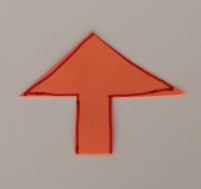How To Train Your Robot To Jump is a very simple game. On purpose.
The point of the game is to teach one simple concept: automation. Not how to write a program to solve a problem, but rather what a program is: a recipe for an automated task. The child uses symbols to express a “mechanical” output. Mom or dad are not jumping until he or she has positioned all the arrows. It is the simplest notion of programming I could think of.
Why not something else?
To figure out how this compared with other available options, I exposed my 2.5 year-old son to iPad apps like Daisy the Dinosaur, but the features were too advanced for him. Toddlers can’t actually read words like “jump” and “roll” so I had to do all the work. He just wanted to press the “play” button. However, if the app developers modified their UI with symbols instead of words, he might have understood what to do. Even then, though, I don’t think I’d have the same connection and fun with him as with jumping up and down together.
I also had my son try to “program in order to solve a problem” using the Angry Birds programming app. There were too many distractions for him. There are too many UI components plus he doesn’t understand what a step or turn signifies and why it’s needed. He just wanted to have the bird move straight to the piggy. Same with Robot Turtles. There were too many moving pieces (i.e., distractions). All these are great options for later, though.
One project where I think the use of technology simplifies the experience for toddlers is Bo & Yana’s robot kit, which I’ve pre-ordered and can’t wait to try with him.
Running the game
In terms of the materials for the game, you need paper, markers and scissors to do some arts and crafts and create arrows like this:
This is a fun time for the child to work with you to build the arrows. It gives you the chance to talk about what the arrows mean during the game while you make them. Be as creative as you like during this step and build some fancy arrows.
In terms of playing, have the child arrange arrows in sequence like so:
and tell them that if an arrow is pointing up you will jump and if it’s pointing down you will drop (or do a push-up etc.). You should start with a single arrow and add more soon after. We made 4 arrows and we could have used more.
The arrow placement will most likely not be so orderly. That’s OK. Keep the game a low-barrier-to-entry experience for the child. Don’t fixate on having the arrows ordered. Just point to a sequence you are going to do and then do the “workout”. You can also tell them that you want to jump up 3 times and let them figure out how to place the arrows (if you want to engage into light problem solving). Also, it’s possible that they will want you to arrange the arrows and that they do the jumping. This is the perfect hook for them to learn to interpret the “program”. Have them do some jumping, then alternate. The whole game won’t last more than 10-15 minutes.
And feel free to use other symbols for doing new moves or prefix the symbols with numbers to show the effect of counting. When we played the game multiple stuffed animals and dinosaurs were involved 🙂
I hope we learned something useful today,
DrTechniko


